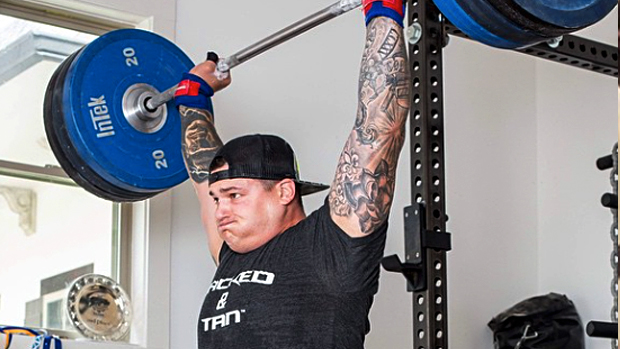1. Squat
It doesn't need to be heavy every time, but this basic movement pattern should be loaded in some fashion on a daily basis.
Focus on improving strength, mobility, and proficiency in all squatting and lunging movements. Back squats, front squats, Zercher squats, lunges, tuck jumps, goblet squats, dumbbell or kettlebell front squats and lunges, etc. all have a place.
With the exception of heavy back squats, any other squatting or lunging variation should be done with the weight starting on the floor. Build the legs. They are the base of the body.
2. Hinge
If squats build the base of the body, then the hinge builds athletic potential via explosive, strong, powerful hips. Hinge on a daily basis.
Deadlifts, cleans, and snatches are fantastic exercises for building the ability to hinge well. Kettlebell or dumbbell snatches and swings can be done for higher reps on lighter days to build strength endurance, but don't shy away from doing more than three reps per set on the deadlift.
A strong back, well-developed rhomboids, and thick, strong traps are one of the hallmarks of an athletic body.
3. Pull
Strengthen the pull-up. Do them for multiple reps. Add load and become strong in weighted chin-ups. Bring back the classic rope climb. Attach a rope to a sled and drag heavy weight across the horizontal plane.
Dumbbell or kettlebell snatches and rows also build grip strength and assist in upper-back development, which is crucial for many lifts and athletic events. Pull-ups, rope climbs, and weighted chin-ups should make up the bulk of back and biceps training.
Curl and row variations have their place, but spend several weeks augmenting pull-up and chin-up training with heavy rope drags, kettlebell snatching, and high-rep single-arm rows and you'll see great strength gains in all aspects of pulling.
4. Press
Most athletes don't need to press as heavily, or as often, as they pull. But all types of pressing can play a part.
If you pick a pressing variation that's psychologically stimulating and physiologically compatible with your body, settle in and improve that particular press, whether it's bench press, overhead press, push press, the single-arm press, dumbbell press, etc.
And remember, there has never been an athlete that has outgrown push-ups and dips. Do them.
5. Move heavy weights long distances
Carry, push, pull, and drag anything heavy until you can't anymore. Farmer's carries, Zercher carries (see video above), sled sprints and pushes, sled drags, sandbag carries, etc. These are important for general work capacity, core strength, grip, forearm, and back strength. They build what Dan John calls "anaconda strength."
Athletes, especially combat athletes who include loaded carries frequently in training, improve their ability to take an impact and deliver one. Include any variation of loaded carries a few times a week. Doing it every single day in some variation wouldn't hurt either.
6. Get tough
Train with intensity. Train long. Train hard. Overcome the mental barriers and self-imposed limitations. Train in the cold. Train in the rain. Get uncomfortable. There aren't very many truly strong or fit people in the world. There are even fewer who are strong, fit, and tough.
7. Fuel up
The athletic world has been ravaged by diet cults and fads. Use common-sense nutrition principles and eat according to your physical development goals.
8. Run
If you think of yourself as an athlete, then run. The wrestler, linebacker, midfielder, boxer, and bodybuilder should all run. Run sprints, distances, and steep hills. Run through the mountains.
Running fast is primal and exciting. Do it in ways compatible with performance goals, but don't make up excuses or believe the contemporary pseudoscience about why running is bad for you. Heart attacks, cigarettes, and cocaine are bad for you. Running and sprinting are not.
9. Mentor others
An athlete endowed with talent, forged by hard work, and blessed with success should spend time passing the torch. Don't be selfish.




